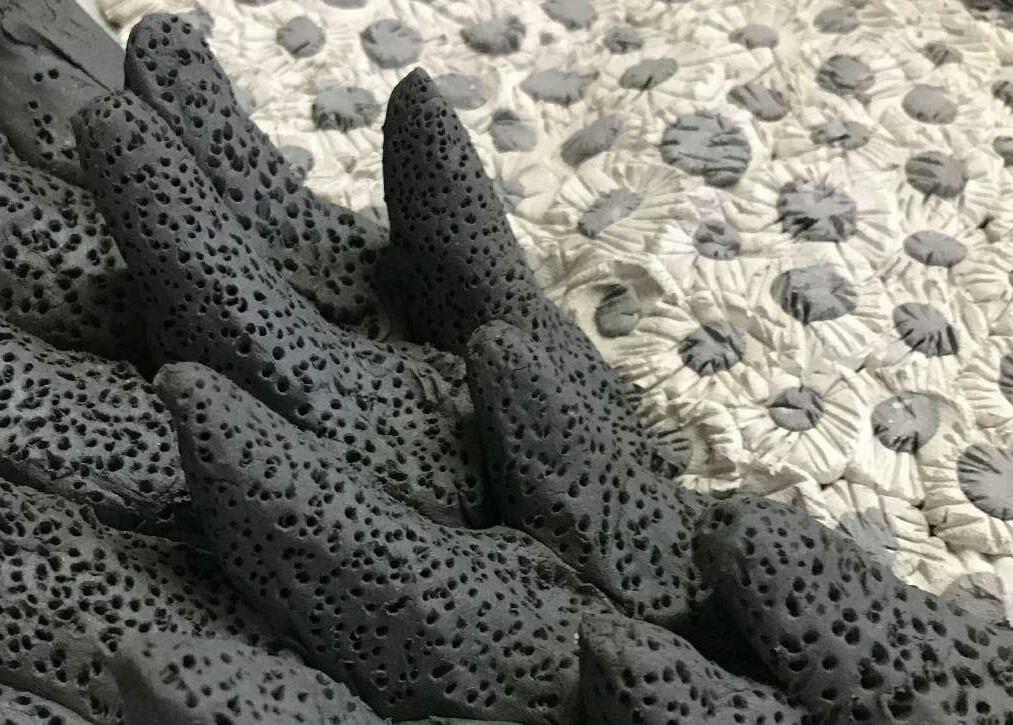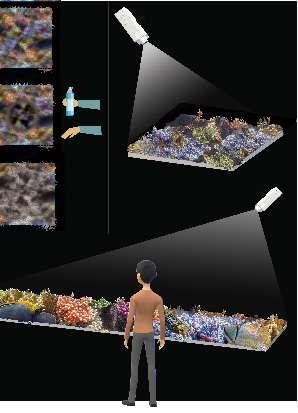
7 minute read
Diving Through Direction
Diving into Directions
Inclined/fascinated towards Cultural aspects and Aesthetics of corals.
Advertisement
Research and source of concepts from cultural and aesthetic life of corals
Overview of Corals
Coral Cultural Aspects
THE MEDITERRANEAN RED CORAL
These are used from a very early date, for decoration and as a protective charm. It was considered that In the 1st century, Pliny the Elder records both its use as a charm to protect children and its scarcity as a result of its export to India also, In the second half of the 19th century, teething rings were still being made with coral. But now these red corals are used for jewelry and decorative purposes This trade-in the hard coral stone was estimated to be worth around 200 million dollars a year
SPIRITUAL ATTRIBUTES OF CORALS
Corals have a pride of place among the nine astrological gemstones. That makes the value of these corals as a piece of jewelry, also they are valued in other fields such as astrology, medicine, and healing, because they are known to be having a certain spiritual identity there are ways to wear them for complete benefit, they need to be worn with correct spiritual knowledge.

NATIVE PEOPLE LIVING NEAR CORAL REEFS AND THEIR CULTURAL BELIEFS

Sinai Peninsula Egypt
Yidinji people, the Great Barrier Reef
Native Hawaiians
India, Onges, the Great Andamanese, and the Jarawas, sentinelese
Aboriginals and Torres Strait Islander
Fascinating stories and beliefs of Native People
Stories that fascinated me to know more about their culture and values for corals.
The Beginning of Life

Hawaiian Beliefs
Hawaiian people have a deep connection to land and sea with a personal attachment to the nature as they think that all life are interrelated, with a belief from the ancient chant Kumulipo explains how life began, this chant is more than two thousand lines which are practiced and shared over generations as it was said that it begins with cosmic darkness. The chant tells that Ko’a which is a coral polyp was the first organism created which was followed by seastar, cucumber, and urchins each with increasing complexity, They consider coral as Akua that provide birth & death to both people and the island.
This chant also teaches that life in the sea and on land are inexorably connected as what is done on land shows the impact on the seas too. They recognize that these organisms are the building block of all life shared on earth, and it is our Kuleana (responsibility) to preserve and protect all living organisms as we all come from the same night, slime, from the coral polyps.
The Great Barrier Reef
Stories of its creation
100m
150m

The story by Yadinji People, According to the creation myth of the Yidinji people, the Great Barrier Reef was formed after Bhiral, The Creator, threw lava from the sky. As the story goes, Bhiral was angered after two brothers went out fishing, and speared a particular fish that they had been told not to hunt.
It was said the creator placed a huge fantasy fish in the ocean to regulate the ecosystem, but the greed of the two brothers broke the law by spearing the fish for their needs by which the creator in anger threw the burning lava into the ocean and the sea level to rise and when it cools down it becomes the great barrier reef.
Coral Bleaching
Vulnerable condition of the corals, Bleaching affects the decoloration of corals into a white calcium carbonate structure, also called the coral skeleton.
Aesthetic Loss

How exactly this happens?
Coral bleaching happens when algae leave the structure and corals started to fade away into a white skeleton until it looks bleached, due to the rise of temperature of waters, pollution, and other causes and if the structure can not develop algae again it will ultimately die.
Corals are fragile and sensitive to temperature changes, and pollution which affects photosynthesis and calcification of their structures, making them prone to diseases and even death.
TRIGGERS OF CORAL BLEACHING
Heat Wave/ Natural Disaster
Many causes threaten the corals and demolish their beauty, for example, pollution from plastics, anti-fouling paint, leaking fuels, and cosmetics or health care products that we use are generally combined with a chemical that leads to coral bleaching.
Not only does pollution through chemicals threaten coral but some careless activities also damage corals like the untrained divers can trample fragile corals, lack of knowledge to the visitors can hamper the life of corals also, and practices like blast fishing by using dynamite or explosives can stress out corals so in most cases corals expel their zooxanthellae and if not recovered from shock they might die.
Increased greenhouse gases from deforestation, burning of fossil fuels, and heavy use of chemical gases can cause the temperature to rise, and change storm patterns and this contributes to the rise in sea level. These changes cause more coral bleaching. While destruction from storms, tsunamis, and other natural causes.

ITS IMPACT ON WILDLIFE
What is the impact of coral bleaching on wildlife, as it was mentioned that coral is a home for 4000 species of marine organisms whose existence belongs to corals? Due to coral bleaching effects, species may face extinction and there might be a disturbance in the ocean food chains. The reef can no longer provide shelter, spawning ground, and protection to those organisms hence it may lead to vast destruction in the marine ecosystem.


Photo by Francesco Ungaro on Unsplash
ITS IMPACT ON HUMANS
What is the impact of bleaching on humans, well as it was stated in a report that coral bleaching impacts people’s livelihood, food security and safety, and safety from the waves and storms as coral plays the role of an obstacle to these natural causes arising from the sea to the coastal regions?
When corals are bleached that means there will be hardly any life left which means depriving in fishes species that are the primary source of income or food for the locals. Not just it is considerable for locals but the larger part of tourism also pays a great debt, how? Tourism brings billions of dollars each year that supports the employment/job to many if corals are bleached then the earnings and employment can be at risk.
Vulnerable Indian Corals
El Niño was heart-wrenching for Indian corals were at their most vulnerable stage.
El Nino Events
The most heart-wrenching events happened to Indian corals, the team of Indian researchers warned about the rising temperatures which we are already going through. They analyzed data collected from the sea surface since 1982, has found that three mass bleaching events occurred that impacted five major Indian coral reef regions, Andaman, Nicobar, Lakshadweep, Gulf of Mannar, and Kutch. Thee were the regions that experienced the hottest weather, where Andaman, Nicobar, and Gulf of Kachch were severely affected in 2010 whereas Lakshadweep and Gulf of Mannar experienced similar conditions in 2016.
The event that bothered the corals of India was the El Nino event that caused mass destruction in Lakshadweep in 1998 and 2010, 1998 which left behind a catastrophe that initially made corals vulnerable to revive yet within a few years many reefs started to develop new corals and they grew at an astounding rate. 2010 brought another large El Nino event that bring another decline in the growth of corals but this time there was regrowth in some areas as this event was most hearth wrenching because reefs were halfway from recovery from the last catastrophic destruction.

Other Human-caused bleaching factors
Our daily use products are made of harmful chemicals that can also cause bleaching of corals
Humans Invasion
Some of the products that we use on daily basis can be harmful to corals, do you know?
For example, some products contain a few chemicals which can contaminate waters and become poison to the corals, Oxybenzone and Octinoxate which are used in 70%80% of sunscreens and washes off when we swim or shower can end up in the oceans. But how? So, a study shows that around 14,000 metric tons of sunscreens are released into the oceans every year, and the water carries chemicals around the world to the oceans. Some of the products that contain Octinoxate chemicals are, Skin and cosmetics products, Makeup Foundation, Hair Dye, Shampoo, Lotion, Nail Polish, and Lip Balm other products that contain Oxybenzone chemicals are, Fragrances & Sunscreens.
Zinc Oxide nanoparticles are being used in industries of Rubber, Paint, Coatings, and Cosmetics whereas Ultrafine Tio2 is used in housing and construction as an addition to paints, plastics, cement, windows, and other products, the use is for ultraviolet absorption and photocatalytic sterilizing properties, for example, antifogging coating or self-cleaning windows, these all chemical can be enough to suffocate the corals till they are completely vulnerable to survive.











